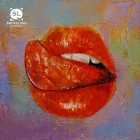First of all, love the title. So much of the telling here gets its momentum from it, which makes me wonder: How did you happen upon this story?
I had a mishap with a roommate’s toaster oven last spring, and while I was scrubbing it clean (and mentally composing my own sheepish apology note), I found myself asking the question, “How could this have been worse?” It wasn’t long before an answer came: “A mythical creature could have destroyed her entire closet.” Naturally, this raised other questions—what kind of person would own a toy chimaera? Where did she get it? How do you go about explaining to someone you barely know that their entire closet burned down? And so Annaliska was born.
The tone of this story seems guarded, despite this being a confessional. Can you speak to why you made the choice for this to be a letter and how that affected the narration?
The letter form was a useful limitation because it forced me to constantly ask the question, “What would Annaliska tell Irene?” I always knew the story would be told as a letter, but I didn’t initially realize how much the narrator’s conflict was implicit in the letter form itself. Annaliska is torn between wanting to explain herself and not wanting to reveal too much of her life. Writing this letter, for her, means interacting with the outside world in a way she’s been actively trained by her father not to do.
There is a sense of darkness and desperation here, starting from the title and leaving a reader with a tight chest by the end. Did you see her as desperate? I am also curious if you made any deliberate choices to reflect the panic and resignation that the reader ultimately ends up feeling.
I’m so fascinated by the way my own understanding of this story shifted while I was writing. I initially started from a place of humor; I thought I was writing a lighthearted piece about a zany teenager who’s trying to ramble her way out of a bad situation. Well—turns out Annaliska had other ideas. I wasn’t very far into it before I was struck by the depth of her emotion, by the tension between her old life with her father and her current life with Irene, and by the gaping absence she feels as she describes her mother. It also occurred to me that regardless of whether you bring a toy chimaera with you, the transition away from home/childhood to college can feel cataclysmic, and anything that goes wrong with a new roommate during that period can feel like the end of the world. I wanted to capture that feeling of dread and layer it with Annaliska’s … very unusual circumstances.
So yes, I do see her as desperate by the end, because she has no idea what’s going to happen when Irene comes home. She has no idea what happens when someone faces the consequences of their actions, because she’s never seen that modeled. I was surprised at the end by the revelation that she’s writing the letter in an attempt to keep from running away, but I also see a glimmer of hope in that decision. Annaliska, like so many young people out on their own for the first time, is in the middle of an identity crisis, and she chooses to do the thing that feels less safe. There would have been a lot less panic and desperation in this story if she had simply scooped up the chimaera and gone home to her father. But it also would have been less interesting, at least for me.
For me, writing this story felt less like making deliberate choices and more like picking up on clues. I noted the places where Annaliska slowed down, her usual frenzied voice giving way to something more honest. One of the earliest major clues was the sentence, “So you see, Irene, this is pretty much the first problem I’ve encountered where the solution wasn’t to move.” That was a moment when I began to understand the source of Annaliska’s panic.
Do you see the protagonist as a collector as well? Her collections seem to revolve around loss, even being reflected in her listing of the burnt items. Was this an intentional thing or did you find the story coming to it organically?
I wish I could say that was intentional! During the writing process, I felt as if Irene and I were in similar positions: We were both getting bits and pieces of this story over time. It was only in hindsight that I understood how the pieces fit together to reveal this character’s psyche. So much of this story centers on Annaliska struggling with whether she’ll be like her father, and that struggle reveals itself through tiny choices: Does she keep/find the chimaera or does she let it go? Does she choose to reveal her life to Irene or does she keep it hidden? Does she flee the scene or does she stay to await Irene’s wrath? As I look back at it now, her lists do reflect the collection mentality of her father, but the things she chooses to collect are very different. Annaliska collects lost items (Irene’s charred shirt, her mother’s laugh), while her father collects living things.
What is the strangest thing you have ever collected? Do you still have it, and why?
While going through boxes at my grandparents’ house, I ran across an old yellow Yellowstone Park flyer that says, “WARNING: MANY VISITORS HAVE BEEN GORED BY BUFFALO. DO NOT APPROACH BUFFALO.” It’s been hanging on my bedroom door ever since. For many years, it was a veiled reference to my cat. I’ve always found it amusing; I have no idea what my visitors think.




 The core workshop of SmokeLong Fitness is all in writing, so you can take part from anywhere at anytime. We are excited about creating a supportive, consistent and structured environment for flash writers to work on their craft in a community. We are thrilled and proud to say that our workshop participants have won, placed, or been listed in every major flash competition. Community works.
The core workshop of SmokeLong Fitness is all in writing, so you can take part from anywhere at anytime. We are excited about creating a supportive, consistent and structured environment for flash writers to work on their craft in a community. We are thrilled and proud to say that our workshop participants have won, placed, or been listed in every major flash competition. Community works.